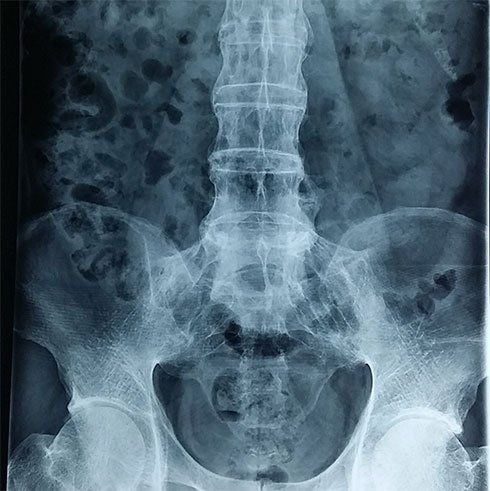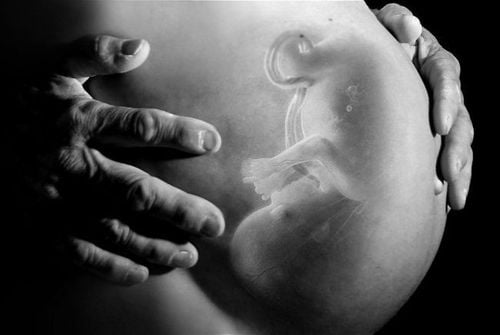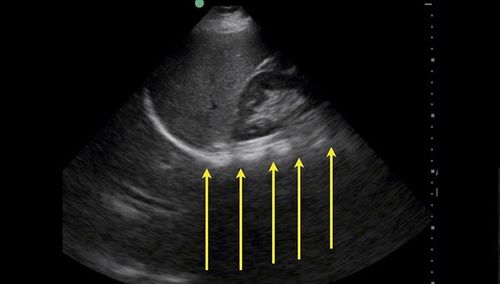This is an automatically translated article.
The article is professionally consulted by Master, Doctor Nguyen Thanh Nam - Radiologist - Department of Diagnostic Imaging - Vinmec Danang International General Hospital.Pelvic X-ray is a very valuable method in the diagnosis and treatment of health problems. For pregnant women, a pelvic X-ray may be ordered by the doctor to predict the likelihood of a normal delivery for a pregnant woman.
1. Pelvic Anatomy
The pelvis is likened to a support, containing internal organs including the bladder, rectum, uterus, and ovaries (in women). The pelvis is made up of 4 bones: In front and 2 sides are 2 pelvis, in the back are the sacrum above and coccyx below. Specifically:2 pelvis: 2 flat, large and propeller-shaped bones; Sacral bone: Consists of 5 segments, has 2 sides and 2 sides, the top of the sacrum is adjacent to the coccyx; The coccyx: There are 4-6 segments, including one front, one back and two edges. The 4 bones of the pelvis are joined together by 4 semi-moving joints: The front is the pubic joint, the 2 sides are the sacroiliac joints and the back is the sacrum joint. The joints of the pelvis are capable of dilating during labor, creating favorable conditions for the fetal head to pass through the pelvis. However, the ability to expand the pelvic joints will decrease if the mother is old, the pregnant woman is sedentary during pregnancy.
The inside of the pelvis has an anonymous line, dividing the pelvis into 2 parts: The upper part is the large pelvis (the large pelvis), the lower part is the small pelvis (the small pelvis).
2. Learn pelvic radiography technique
An X-ray is a procedure that uses a small amount of radiation to take a picture of the pelvis, which surrounds the hip area. Safe, painless, and safe pelvic X-ray technique is very important in the process of examining and diagnosing related diseases.
To protect certain parts of the body, the patient is required to wear a lead vest; The technician guides the shooting posture; Technician operating X-ray machine; The patient stands still for a few seconds during the scan to avoid blurred X-ray images. If the patient is unable to move to the X-ray room, the portable X-ray machine will be brought to the bedside. The patient can be taken in a lying or sitting position.
During the scan, the X-ray machine sends a beam of radiation through the pelvis and the image is recorded on film or a computer. The X-ray image shows the bones of the pelvis, including the 2 hip bones, the sacrum, and the coccyx. On X-ray images, the bone will appear dense, blocking radiation, and the bone will appear white. Body tissues (muscle and fat) that allow radiation to pass through are dark in color.
2.2 Role of Pelvic X-ray Pelvic X-ray technique is indicated to find the cause of symptoms of swelling, pain, deformity in the pelvis, hips or thighs. In addition, this method can also detect fractures after trauma, problems such as tumors, infections in the pelvic area, ... For pregnant women, pelvic X-ray It also helps predict the likelihood of a normal delivery.
3. Can pregnant women have a pelvic X-ray?
Usually, pregnant women with a height of less than 150cm or a small butt will have a narrow or limited pelvis, making it difficult to give birth vaginally. A pelvic X-ray is indicated in cases where the doctor wants to assess whether a woman is able to give birth vaginally. The usual indications include:
Estimate the weight of the large fetus (the baby weighs more than 3.5kg); I compare the butt; Conviction , old cesarean scar is not due to narrow or limited pelvic cause; The time for a pelvic X-ray is usually 38 weeks gestation. X-rays are a form of radiation that cannot be seen with the naked eye. X-rays are used in X-rays of diseases of the bones, lungs, and many other organs. X-rays can be associated with a risk of cancer, acute leukemia for the fetus, but this risk is very small.
The fetus is at risk of developing cancer later in life if exposed to radiation doses of 2 - 6 rads. The fetus is at risk of birth defects if exposed to radiation doses above 5 rads. Meanwhile, the radiation dose with pelvic imaging is only about 1.1 mGy (1 rads = 10 mGys). Small gestational age is easily affected. For fetuses with a gestational age of more than 38 weeks, the degree of influence is also lower.
Therefore, when X-rays are used for diagnosis (such as pelvic X-rays), the radiation dose used is very low, much lower than the dose harmful to the fetus. At the same time, the indication to perform pelvic X-ray is when the fetus is 38 weeks old, so it hardly affects the baby.
However, the appointment of X-rays for pregnant women should also be limited, only done when necessary as prescribed by the doctor and taken under the support of preventive measures. At the same time, pregnant women need to strictly follow the doctor's instructions during the X-ray.
Master Doctor Nguyen Thanh Nam used to be a Lecturer in Diagnostic Imaging, Hue University of Medicine and Pharmacy with good English and Russian skills and over 10 years of experience in the fields of Diagnostic Imaging.
Please dial HOTLINE for more information or register for an appointment HERE. Download MyVinmec app to make appointments faster and to manage your bookings easily.














